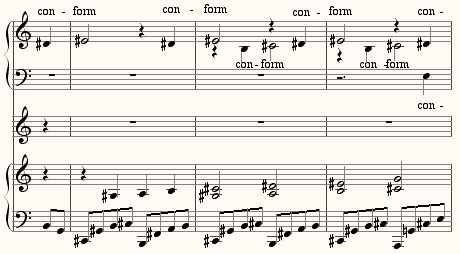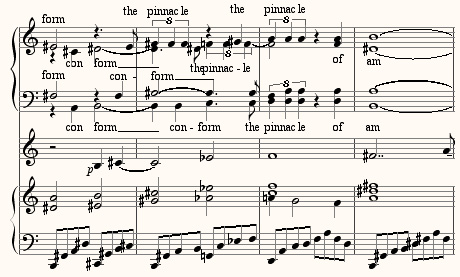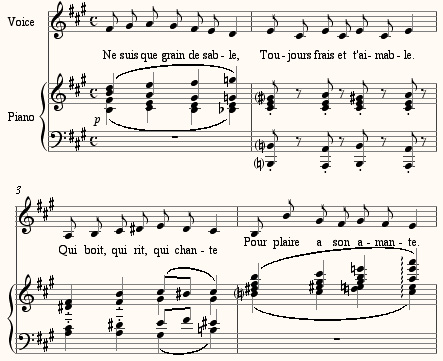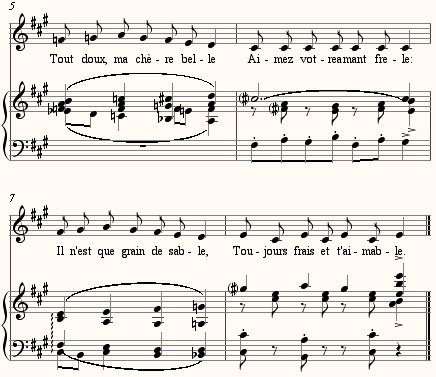PostClassic: November 2006 Archives
Galen Brown makes an argument that the demise of Tower Records is no big deal. I almost believe him. Still, there's one telling fact no one's brought up. Last spring Tower finally opened a "Kyle Gann" bin. A few months later, the place "goes bankrupt."
Coincidence? I think not.
I played my 20th-century music class several tracks from John Oswald's (in)famous 1990 Plunderphonics CD, in which he took illegal samples from Michael Jackson, the Beatles, Dolly Parton, The Rite of Spring, and other sources, making inventive new works by mixing, subverting, looping, and speed-shifting them. (Even though he gave the discs away for free he was threatened with legal action, and had to destroy 300 of the 1000 copies. I was a recipient of one of the original 700, a rare disc indeed.) As we were listening, I realized, though, how familiar these techniques are to my students now, how many of them had performed similar tricks on their laptops.
Next day I played Robert Ashley's Perfect Lives video. When I first saw it in 1982, its nonlinear overlays and screens-within-screens seemed like a totally new artform, and no one knew what to make of it. Now I realized that my students were comparing it in their heads with 20 years of slickly-produced MTV.
I'm old enough that the stunning technological advances of my youth have lost all punch as such, and will never have the impact on my students they did on me. Those works will have to survive - as, indeed, they always did have to - on their intrinsic artistic merits, and they get no extra points today for having been first at what they did. One of my students generously said that the audio roughness of Oswald's techniques made his music seem grittier and more authentic than similar attempts today. And I was wryly gratified by a general complaint that Ashley's video contained too much information to take in at one sitting. I asked if anyone had ever tried to read Finnegans Wake.
Today in three hours I finally finished my setting of E.E. Cummings' My father moved through dooms of love, in which James Bagwell will conduct the Dessoff Choir on March 10. I had quit working on the piece in July because I hit a snag. The setting of the following words just wasn't right, and so the accompaniment (for piano and violin) wouldn't write itself, and I knew it was because I didn't really understand them:
then let men kill which cannot share,
let blood and flesh be mud and mire,
scheming imagine, passion willed,
freedom a drug that's bought and soldgiving to steal and cruel kind,
a heart to fear, to doubt a mind,
to differ a disease of same,
conform the pinnacle of am
(You may think me foolish for finding this difficult, but outside my field I'm not very bright about a lot of things.) Looking at it fresh after four months' hiatus, I suddenly realized that in "to differ a disease of same" the "same" refers to "mind" in the previous line, and that I needed to separate out the phrase "to differ" as the subject of the rest of the line. Cummings is describing how adept his late father was at negotiating a world in which men kill out of selfishness, in which imagination is turned to the service of schemes, in which to differ is considered a disease of the mind, and to conform is considered the pinnacle of being: a world not unlike the one I live in. "If every friend became his foe," he says of his father, "he'd laugh and build a world with snow."
Not having understood this clearly, I had set the words too quickly, relying on only their rhythm. The passage was merely transitional. A "merely transitional" passage is a flaw: every moment of a work has to show the same intensity of care and focus, has to bring its own delight to the listener. So now I set off the words "to differ," and when I got to the word "conform," I counterintuitively brought the music to a halt, repeating it over and over, adding five new measures in the process. "Conform" is what I consider the ugliest word in the English language, the most evil, most heinous word ever devised. It flashes at us from every billboard, is the surreptitious motto of every institute of higher learning, is the directive underlying every newspaper review, the unspoken impetus behind every rejection, the veiled urging behind every advertisement. Hardly can one turn anywhere without hearing the world shout "conform!" If you will behave and be one of the good Stepford composers, your orchestra pieces will be celebrated by the bigshots. If you will join the Stepford professors, the administration will shower favors on you. If you will only conform, the powers that be will welcome you into their lower ranks - pending continued good behavior, of course. "The virtue in most request," wrote Emerson, "is conformity."
And so what I had missed was that Cummings was offering me an opportunity for supreme irony. Over soothing, undulating chords I reiterated "conform, conform, conform" in dulcet and seductive tones, just like the world does. Suddenly, instead of an undistinctive transitional passage, this became (as I had inchoately sensed it would) the emotional center of the piece, a serenely damning indictment of the world that one nearly has to have a nonconformist streak to appreciate:


You'll note that "the pinnacle of am" only rises to a medium-range B - not a very high pinnacle.
Cummings wrote the poem in 1926, after his father was killed by having his car hit by a train. My father died last April - I had begun writing the piece in anticipation - and Maestro James Bagwell had lost his father the year before. The piece is dedicated to James, in the solidarity of grief.
I paid to read my one-paragraph review online in the Times Literary Supplement, but you shouldn't have to. Here it is, and much thanks to Wiley Hitchcock, my mentor and guiding angel, for alerting me:
"At sixteen," writes Kyle Gann in his book Music Downtown, "I was so enwrapped in John Cage's ideas that I began to feel guilty listening to records when I could be outside listening to traffic". As "new music" columnist for the Village Voice from 1986 to 1998, Gann chronicled the waves of avant-garde musicians filling the lofts of lower Manhattan, a tradition inaugurated in the early 1960s with concerts by conceptual artists like Yoko Ono and Nam June Paik, in which musicians were instructed to bang their heads against the wall, set fire to the sheet music, or "creep into the vagina of a living whale". His assembled writings champion that spirit of playful iconoclasm, ranging from established composers such as Philip Glass and Laurie Anderson to neglected pathbreakers like Harry Partch, a Depression-era hobo who devised a forty-three-note scale and a set of Dr Seuss-style instruments (the Quadrangularis Reversum and the Diamond Marimba, each with its own form of notation). While some of the topics verge on the abstruse, all are rendered fresh and compelling by Gann's passionate commitment to the experimental vision: "no rules, no formulas, no prohibitions, no justifying precedents".
Ninety-two years ago this week, between Nov. 20 and Dec. 2, 1914, Erik Satie penned Trois Poèmes d'Amour, a trio of brief love songs to poems of his own. At the risk of taxing my reader's browser, I offer the first here in its entirety:


One notices right away that the voice sings the same rhythm in all eight measures: six 8th-notes and a quarter-note. This is also true of the other two songs: not only that they use the same rhythm in all eight measures, but that they all use this particular rhythm, six 8th-notes and a quarter-note. Thus not only did Satie write three songs each devoid of rhythmic variety, he wrote three songs with no rhythmic variety among them (save for some peculiar chromatic grace notes in the piano in the third, which the sketches indicate were added as an afterthought just before publication). You can listen to the whole set, which lasts barely two minutes, here, on an old Angel vinyl record with baritone Gabriel Bacquier and pianist Aldo Ciccolini. Rather than a collection of three songs, it is really one song - written three times. And yet, no one of the songs is superior to the others, no one sounds like the authentic model from which the other two were derived. Each has its own slightly distinct atmosphere. Each song is memorable on its own; each could stand on its own. Were you to insert a measure from one song into another, those of us familiar with the songs would find the intrusion jarring.
Since my teenage years I have been mesmerized by the studied blankness of mind that could produce these songs. To write a song, and then, as though you had never written it, to write another with the same rhythm and chordal characteristics, just as fresh, just as authentic, requires a mind that can wipe out the immediate past and return to center. And then, within that song, to write each measure so unmindful of its predecessor that you feel no need for contrast, yet that you can also repeat with no fear of exact repetition, seems like the kind of acute moment-to-moment awareness that Zen masters describe. In the poems, Satie was mimicking the flat rhyme-scheme of 12th-century trouveres. But, lest you conclude that only the texts made this feat possible, remember Satie's similar achievements in formal identity in the far more ambitious contexts of instrumental works: not only the famous Gymnopedies and Sarabandes, but the even more astonishing Pièces Froides and Nocturnes, and to a lesser extent the Gnossiennes. He is capable of writing a third movement virtually identical to the first, or one that quotes the first as though it is not a quotation, but a new creative odyssey leading back into identical material. Like Borges' hero who writes (not rewrites) Cervantes' Don Quixote, Satie was capable of writing the same music twice: not in absent-minded forgetfulness, but in acute awareness of every moment as new.
Having discovered Satie at 15 and instantly recognized him as an old friend, I am more and more trying to achieve the blankness of mind - and also the craft, because contrary to public impression, Satie was a painstaking reviser - that makes pieces like Trois Poèmes d'Amour possible. "What should I do in this section?" is a question I try to prevent from ever arising. By the end of the first measure, everything should be decided, and the only task is to continue. By continue I mean simply to sustain the idea, to keep it alive without having to resort to anything else. Although, it's hardly simple, it's damned difficult: so much easier to move to a contrasting section, to bring in a second idea, to swerve and create a facile "unity" by returning to the original material later. This is what La Monte Young meant, I surmise, when I asked him circa 1991 why the five movements of his early string quartet were so similar, and he replied, after a moment's thought, "Contrast is for people who can't write music" - an unnecessarily dismissive formulation, perhaps, but one I found inspiring. And possibly what Kierkegaard meant when he titled one of his books, "Purity of Heart Is to Will One Thing."
The classical music world - which values educatedness in a composer over discipline of will, and speciously takes variety of techniques as evidence of education - does not much respect this goal, nor Satie. But that's the goal that continues to inspire me. (One piece that achieves it heartbreakingly well is Evensongs by Ingram Marshall, which I have just added to Postclassical Radio.)
I went to the Sequenza 21 concert at CUNY Graduate Center last night, and met in person quite a few people I had known only virtually, including Sequenza 21 guru Jerry Bowles, David Toub, Galen Brown, Ian Moss, and David Salvage. Performances were excellent, and the program divided half-and-half - much like Sequenza 21 itself - between postminimalism and modernism, though the latter was of a refined variety. Composer Dan Goode asked me why Sequenza 21 was moving from virtual existence to real-life events, when most organizations are swimming in the other direction. I replied that it was like internet dating - at some point you have to finally meet the person, to find out for sure how big a disaster you're courting.
In actuality, it was a fun event and prelude to a fun evening out. You can read the official accounts here.
Taking off several weeks in August to write a new work for pianist Sarah Cahill put me way behind in my work, and teaching five courses this semester made catching up a slow process. But I have just officially caught up tonight. Perhaps blogging will resume.
I have been having an unexpectedly good time teaching my course "Populism versus Progress in 20th-Century Music." The students are aggressively thought-provoking. After I gave a long exposition on the origins of minimalism, one asked, "Why do you represent this as somehow a continuation of classical music instead of something else entirely different?" I offered several rationales, all of them noticeably weak and unconvincing. On the other side I did cite the example of California minimalist Harold Budd, who once told me that whenever he walked into a record store and found his discs in the classical bin, he moved them to pop. So - why connect minimalism with classical music at all? Why not declare our independence?
In another class I played several examples of "postmodern" pieces that combined classical and symphonic idioms with jazz or rock or country and western, starting with William Bolcom's Songs of Innocence and Experience and continuing with diverse examples by Christopher Rouse, Mason Bates, and Erkki-Sven Tüür. Virtually every such piece was met with an almost unanimous thumbs-down. First of all, the idea that orchestras would try to lure younger listeners into the concert hall with orchestra pieces influenced by Led Zeppelin was seen as transparently condescending. The idea that rock fans might in any way get the same kind of pleasure they get from hip-hop from a bunch of guys in tuxedos was apparently ludicrous. Even the more thoughtful, less gimmicky examples, though, fared badly. The idea of classical musicians attempting to simulate the energy of rock or jazz turns them off, and even the audio image of a jazz band alternating with the orchestra injures their sense of good taste. (The class's John Zorn fan protested, "Where's the unity?", and I shot back, "Hey, you're the Zorn fan." "I know," he answered, "but his style quotations are all in short snippets.")
But I'm not satisfied, and I will continue to press the point. Why isn't it acceptable (and I'm not claiming it is - I'm as bothered as they are, but I'm an old fart) to present two highly opposed musical styles in one piece? As one young woman theorized, perhaps in 1924 audiences experienced the same jarring dislocation with the jazz elements of Darius Milhaud's La Creation du Monde, and perhaps 80 years from now people will be so inured to such style clashes that Songs of Innocence and Experience will sound tame. I want a better excuse for why they think such music doesn't work, can't work, than just, they're not used to it.
 Dutch composer Samuel Vriezen was just here at Bard, supervising a rehearsal of his piece The Weather Riots, which my Open Instrumentation Ensemble is playing soon, and giving a wonderfully lively lecture about his compositional process. (He's in New York for the riotous-looking Sequenza 21 concert happening this Monday at CUNY Graduate Center, where Weather Riots will also be performed, and which you can find out more about here.) Samuel usually writes pieces in which all the performers are playing similar material at the same time, unsynchronized. As we learned in rehearsal, it takes more virtuosity than you'd think from looking at the scores. His music has an interesting relationship to serialism (in the types of angular gestures he uses), to minimalism (since those gestures, all in 8th-notes, tend to get repeated and echo from instrument to instrument), and to the kind of experimental performance tradition of Cage, Earle Brown, and Christian Wolff.
Dutch composer Samuel Vriezen was just here at Bard, supervising a rehearsal of his piece The Weather Riots, which my Open Instrumentation Ensemble is playing soon, and giving a wonderfully lively lecture about his compositional process. (He's in New York for the riotous-looking Sequenza 21 concert happening this Monday at CUNY Graduate Center, where Weather Riots will also be performed, and which you can find out more about here.) Samuel usually writes pieces in which all the performers are playing similar material at the same time, unsynchronized. As we learned in rehearsal, it takes more virtuosity than you'd think from looking at the scores. His music has an interesting relationship to serialism (in the types of angular gestures he uses), to minimalism (since those gestures, all in 8th-notes, tend to get repeated and echo from instrument to instrument), and to the kind of experimental performance tradition of Cage, Earle Brown, and Christian Wolff.
In the '70s versions of such music, no one was much interested in controlling the results, and the pieces tended not to have a recognizable identity. Samuel, however, with his incisive mathematical mind, has figured out ways to base all his gestures on a finite number of formulas (a postminimal practice) in such a way that certain echoings among players are pretty much guaranteed to happen. That's what's so fun about rehearsing Weather Riots - you're playing without regard to the rest of the ensemble, you're even choosing your own route through the material, yet you invariably hear echoes of your own notes popping around elsewhere. He can even write multi-movement works like Panoramic Variations (scroll down) in which the movements, though based on identical techniques, are quite distinct from each other. My favorite piece of his so far is an epic two-piano work called 20 Worlds - a "world,' in his terminology, being defined by a particular combination of gesture types. I gave up this kind of incompletely notated performance practice twenty years ago because the results seemed so hit-or-miss. He's completely solved the problem: pieces whose details are different in every performance, but whose overall aura is remarkably consistent, recognizable, and quite lovely and lively. Brace yourself for a Vriezen onslaught on Postclassic Radio soon.
Samuel and I had a lot of great discussions too, and I learned some things. He says that, just as Schoenberg became an overwhelming influence in American musical academia in the '60s and '70s, the influence that flooded Dutch practice, and thus the composer whose exalted status young Dutch composers have most learned to resent, was Stravinsky. He also told a story about Cage I hadn't heard. Cage's 74, one of his late "number" pieces, is a ten-minute piece for 74-piece orchestra in which the bass instruments all read from one part, and the treble instruments from another. It seems that Cage received a fax one morning commissioning the work, wrote it in two hours, and faxed it back that afternoon. That's the kind of compositional technique I'm looking for.
Our pianist had the day's best line. Showing up late for a meeting, he said, "Sorry, I was out late last night celebrating the fact that the terrorists won. I burned an American flag."
Young (relative to me) composer Galen Brown has a musically and visually attractive music video up on YouTube, sort of a neo-geo Koyaanisqatsi for the new generation. Bright, passionate music for a brighter, more passionate new day.
So for a lot of us, there's more at stake in Tuesday's elections than simply whether the Democrats will take control of the House or the Senate. It's a question of national identity, of finding out who we are -- and if we're a "we" at all. For six years, we've been waiting for the America we thought we knew to come back. And now, as we wait for the spinning windows in the great democratic slot machine to stop, we're torn between hope that it'll display the country we thought we knew, and fear that it'll show something else.
We thought America was conservative enough not to trash its most cherished traditions just because of one terrorist attack. We thought America was liberal enough to try to understand why others might hate us, not just to lash out self-righteously. We thought America was wise enough not to start an unprovoked, immoral and highly risky war. We thought America had enough self-respect not to let itself be ordered around by a shameless, lying bully.
We were proved wrong. But we haven't given up. Now our hopes are more modest. Now we're simply hoping that those of our fellow citizens who let us down so badly two years ago throw the bums out. That good old American common sense will prevail. In short, that we haven't completely lost it.
Brian McLaren alerted me to a report by an organization called the Identity Project (at the ominous URL www.PapersPlease.org) that the Department of Homeland Security has proposed that, effective January, no U.S. Citizen be allowed to leave the country unless his or her name appears on a clearance list. As another organization called Friends of Liberty amplifies:
Think this can't happen? Think again. It's ALREADY happening. Earlier this year, [Homeland Security] forbade airlines from transporting an 18-year-old a native-born U.S. citizen, back to the United States. The prohibition lasted nearly six months until it was finally lifted a few weeks ago. Nazi Germany and the Soviet Union are two countries in recent history that didn't allow their citizens to travel abroad without permission. If these regulations go into effect, you can add the United States to this list.
Yesterday, I tried to ignore this and write it off as paranoia. Today, there are banner headlines over the Times' web pages from the State Department warning that starting January 7, U.S. Citizens will need passports to visit Canada and Mexico, and directing us to the State Department for more information.
Meanwhile, speed traps in the Hudson Valley are suddenly more numerous lately, spreading like Kudzu even on the remotest rural roads. A friend and I, in separate incidents, were each pulled over and given breathalyzer tests, which we passed, not based on any evidence of drunkenness. At every gas station I see big signs detailing newly increased ID levels for the purchase of alcohol and cigarettes. There's a creepy sense of a heightened police presence in my life.
When does it stop being paranoia?
Composers Joan Tower and George Tsontakis were in my office today, discussing composition with a student. George, the student's teacher, said, "We've been talking about the problem of how fast you can add contrasting new ideas to a piece without losing the listener and making the piece disunified." Joan replied, "Oh, that's a problem everyone faces." I said, "Adding new ideas? That had never occurred to me."
Sites To See
AJ Ads
AJ Arts Blog Ads
Now you can reach the most discerning arts blog readers on the internet. Target individual blogs or topics in the ArtsJournal ad network.
Advertise Here
AJ Blogs
AJBlogCentral | rssculture
Terry Teachout on the arts in New York City
Andrew Taylor on the business of arts & culture
rock culture approximately
Laura Collins-Hughes on arts, culture and coverage
Richard Kessler on arts education
Douglas McLennan's blog
Dalouge Smith advocates for the Arts
Art from the American Outback
For immediate release: the arts are marketable
No genre is the new genre
David Jays on theatre and dance
Paul Levy measures the Angles
Judith H. Dobrzynski on Culture
John Rockwell on the arts
Jan Herman - arts, media & culture with 'tude
dance
Apollinaire Scherr talks about dance
Tobi Tobias on dance et al...
jazz
Howard Mandel's freelance Urban Improvisation
Focus on New Orleans. Jazz and Other Sounds
Doug Ramsey on Jazz and other matters...
media
Jeff Weinstein's Cultural Mixology
Martha Bayles on Film...
classical music
Greg Sandow performs a book-in-progress
Exploring Orchestras w/ Henry Fogel
Harvey Sachs on music, and various digressions
Bruce Brubaker on all things Piano
Kyle Gann on music after the fact
Greg Sandow on the future of Classical Music
Norman Lebrecht on Shifting Sound Worlds
publishing
Jerome Weeks on Books
Scott McLemee on books, ideas & trash-culture ephemera
theatre
Wendy Rosenfield: covering drama, onstage and off
Chloe Veltman on how culture will save the world
visual
Public Art, Public Space
Regina Hackett takes her Art To Go
John Perreault's art diary
Lee Rosenbaum's Cultural Commentary
Tyler Green's modern & contemporary art blog
